
The blue shark, also known as the great blue shark, is a species of requiem shark, in the family Carcharhinidae, which inhabits deep waters in the world's temperate and tropical oceans. Averaging around 3.1 m (10 ft) and preferring cooler waters, the blue shark migrates long distances, such as from New England to South America. It is listed as Near Threatened by the IUCN.
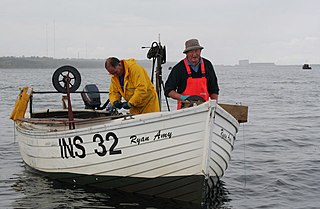
Longline fishing, or longlining, is a commercial fishing angling technique that uses a long main line with baited hooks attached at intervals via short branch lines called snoods or gangions. A snood is attached to the main line using a clip or swivel, with the hook at the other end. Longlines are classified mainly by where they are placed in the water column. This can be at the surface or at the bottom. Lines can also be set by means of an anchor, or left to drift. Hundreds or even thousands of baited hooks can hang from a single line. This can lead to many deaths of different marine species. Longliners – fishing vessels rigged for longlining – commonly target swordfish, tuna, halibut, sablefish and many other species.
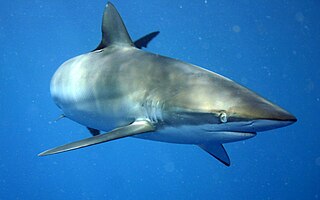
The silky shark, also known by numerous names such as blackspot shark, gray whaler shark, olive shark, ridgeback shark, sickle shark, sickle-shaped shark and sickle silk shark, is a species of requiem shark, in the family Carcharhinidae, named for the smooth texture of its skin. It is one of the most abundant sharks in the pelagic zone, and can be found around the world in tropical waters. Highly mobile and migratory, this shark is most often found over the edge of the continental shelf down to 50 m (164 ft). The silky shark has a slender, streamlined body and typically grows to a length of 2.5 m. It can be distinguished from other large requiem sharks by its relatively small first dorsal fin with a curving rear margin, its tiny second dorsal fin with a long free rear tip, and its long, sickle-shaped pectoral fins. It is a deep, metallic bronze-gray above and white below.

Barracudinas are any member of the marine mesopelagic fish family Paralepididae: 50 or so extant species are found almost worldwide in deep waters. Several genera are known only from fossils dating back to the Ypresian epoch.

Bycatch, in the fishing industry, is a fish or other marine species that is caught unintentionally while fishing for specific species or sizes of wildlife. Bycatch is either the wrong species, the wrong sex, or is undersized or juveniles of the target species. The term "bycatch" is also sometimes used for untargeted catch in other forms of animal harvesting or collecting. Non-marine species that are caught but regarded as generally "undesirable" are referred to as rough fish or coarse fish.

The Antarctic toothfish, also known as the Antarctic cod, is a large, black or brown fish found in very cold (subzero) waters of the Southern Ocean near Antarctica. It is the largest fish in the Southern Ocean, feeding on shrimp and smaller fish, and preyed on by whales, orcas, and seals. It is caught for food and marketed as Chilean sea bass together with its sister species, the more northerly Patagonian toothfish. Often mistakenly called "Antarctic cod", the Antarctic toothfish belongs to the notothen family (Nototheniidae), a group of fish species abundant near Antarctica.
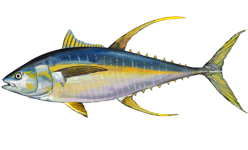
The yellowfin tuna is a species of tuna found in pelagic waters of tropical and subtropical oceans worldwide.

Wahoo is a scombrid fish found worldwide in tropical and subtropical seas. It is best known to sports fishermen, as its speed and high-quality flesh makes it a prized and valued game fish.

Lancetfishes are large oceanic predatory fishes in the genus Alepisaurus in the monogeneric family Alepisauridae.
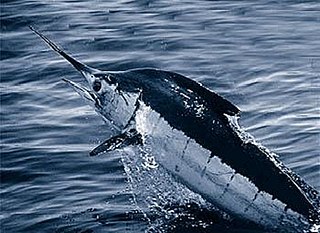
The Atlantic blue marlin is a species of marlin endemic to the Atlantic Ocean. It is closely related to, and usually considered conspecific with, the Indo-Pacific blue marlin, then simply called blue marlin. Some authorities consider both species distinct.

Pelagic fish live in the pelagic zone of ocean or lake waters—being neither close to the bottom nor near the shore—in contrast with demersal fish that live on or near the bottom, and reef fish that are associated with coral reefs.

The bigeye tuna is a species of true tuna of the genus Thunnus, belonging to the wider mackerel family Scombridae. In Hawaiian, it is one of two species known as ʻahi, the other being the yellowfin tuna. Bigeye tuna are found in the open waters of all tropical and temperate oceans, but not in the Mediterranean Sea.

The devil fish or giant devil ray is a species of ray in the family Mobulidae. It is currently listed as endangered, mostly due to bycatch mortality in unrelated fisheries.

The environmental impact of fishing includes issues such as the availability of fish, overfishing, fisheries, and fisheries management; as well as the impact of industrial fishing on other elements of the environment, such as bycatch. These issues are part of marine conservation, and are addressed in fisheries science programs. According to a 2019 FAO report, global production of fish, crustaceans, molluscs and other aquatic animals has continued to grow and reached 172.6 million tonnes in 2017, with an increase of 4.1 percent compared with 2016. There is a growing gap between the supply of fish and demand, due in part to world population growth.
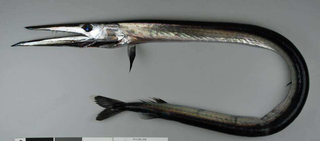
The daggertooths are a genus of marine mesopelagic fish in the order Aulopiformes, the sole genus of the family Anotopteridae. They are found in oceans worldwide, but prefer cooler waters.

Eumecichthys fiski, the unicorn crestfish or unicornfish, is a very rare, little-known species of crestfish in the family Lophotidae, and the only member of the genus Eumecichthys. It likely has a worldwide distribution, having been first discovered offshore of Kalk Bay, South Africa, and subsequently reported from the Sea of Japan, southwest Florida, Clarion Island off Mexico, Hawaii, and India. A report from the Bering Sea may have been in error. It is found in the bathypelagic zone, at a depth of around 1,000 m (3,300 ft).
Galatheacaris abyssalis is a rare species of shrimp, now thought to be a larval stage of another genus, Eugonatonotus.
The gill plate trade is the buying and selling of stingray gill plates for their use in traditional Chinese medicine. The gill plates are harvested from stingrays that are caught intentionally, or caught as bycatch. The plates are sold whole or in a powder form. A single kilogram of the gill plate can be sold for up to US$350, though the price varies by ray species.

Of the twelve species of billfish, there are six species of Billfish in the Indian Ocean.
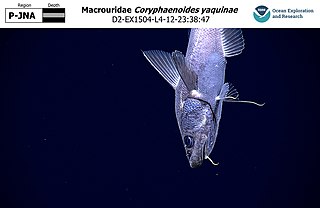
The rough abyssal grenadier is a species of deep-sea grenadier fish in the family Macrouridae. First described as a separate species in 1974, the rough abyssal grenadier was historically confused with its congener, Coryphaenoides armatus. Unlike C. armatus, which has been recorded in the waters of the Atlantic, Pacific, Indian, and Southern oceans, observations of C. yaquinae have been confined exclusively to the Pacific ocean. C. yaquinae tends to inhabit abyssopelagic depths between 3,400 and 5,800 meters. However, observations of C. yaquinae have been made as deep as 7,000 meters (23,000 ft) below sea level.





















